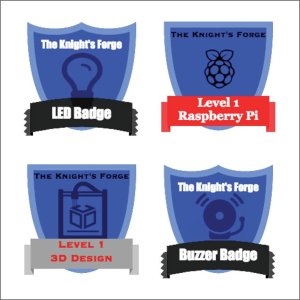Acknowledging Ungraded Skills
An argument for using badges in makerspaces to recognize the skills students gain outside the traditional curriculum.
Your content has been saved!
Go to My Saved Content.One of my goals this year was to find a way to recognize all of the amazing things students do in the makerspace at University Liggett School. It’s open to students all day and after school, and they’re doing amazing things with Python, littleBits, 3D design, Raspberry Pi, and so much more.
While report cards can be used to show parents what students have learned in class—sort of—the makerspace did not have a means to do this. It’s hard to show parents lines of code and have them understand that their child has mastered the skill of making an LED blink. That’s where badging comes in.
I’ve always been interested in the idea of badging to represent learning. Badges in the makerspace make perfect sense because the makerspace is all about creating things and, through that creation, demonstrating skills learned along the way. I took the idea of using digital badges and created sticker versions as well so students can show off their badges on their devices at school.
I know my system is not perfect, but it will grow and evolve over time, just as the makerspace will.
Five Reasons to Try Badging in Your Makerspace
1. Student recognition: One of the fun things about learning a new skill is sharing it with others. A badging system enables students to show off their skills in a digital and physical way. Printing badges on sticker paper allows students to adorn their devices or notebooks with the badges they earn.

2. Documented skills: Keeping track of all of the skills a student learns over their time in the space is important as they progress in their education. Recognizing skills in soldering or programming could help students earn internships or other jobs.
3. Easy sharing: These badges are easy to share because they live in a digital world. Students can share their earned badges with colleges, potential employees, and anyone else they want to show the skills they learned outside of what’s reported through the report card system.
4. Makerspace growth: A traditional curriculum can become cumbersome over the years. It can be hard to change because of red tape. A makerspace has the flexibility to be what the users want it to be, and the badging system allows for documenting the skills students are learning very easily. As new skills are introduced to the space, new badges can be created and presented to students.
5. Student leadership: One of the exciting aspects of a badging system is that it’s not just teachers who can create badges—students can do so as well. They come to school with so many different skill sets, but most of these are not recognized as valuable in the traditional school setting. Working with a teacher, a student can create their own set of requirements for new badges, helping create a makerspace badging system that recognizes a wide variety of skills.
Potential Downsides
With every new idea, of course, there are potential problems, and badging is no different. There’s a possibility that students will use the space only to earn badges—they may be motivated by badges, in other words, not by the learning possibilities of the space. I can see this becoming a problem in places that have not established a maker mentality in their space or school. The question students should be asked when they come to the makerspace is: “What do you want to learn today?” With that question as the driving force, students should focus on the learning rather than on the badges.
There may also be concern about the value of the badges created by teachers and students. What if the badges earned by some students at one school are harder to earn than at another school? What does a Level One Raspberry Pi Badge really mean? As with any assessment system, these questions are going to exist. Time and the reputation earned as students demonstrate their knowledge are key factors. After all, the questions above apply to the way grades are done right now, and colleges view an A from one school differently than they do an A from another. Building a tradition of excellence, and a reputation for it, takes time.
The idea of a makerspace is that it is a spot where people can come and try new things, fail, learn, and try again. A badging system is another example of trying new things and learning as you go. As with most new things, it will go through changes as you learn. As long as people are committed to iterating throughout the process, their badging systems will become better over time.
I’m excited about the badges students are learning and the badges they will create on their own. In the end, it’s about recognizing student achievement, and these badges are just right for right now.
